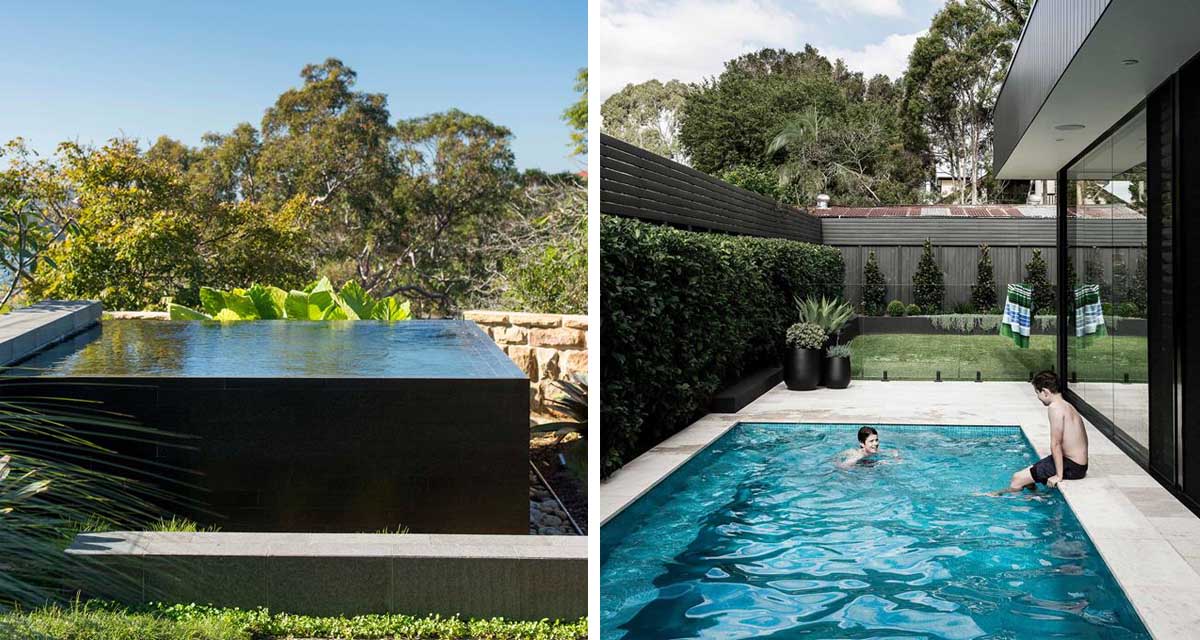While we consider that our forte lies with interiors, our House G project has us continually working on the exteriors and landscaping – including the refurbishment of the swimming pool. Having your own swimming pool is a bigger luxury than ever before. Something our landlocked friends have never taken for granted.
Installing a pool can add significant value to your home and is often considered an investment in your property. It does of course come with it’s own special price tag, so before taking the plunge let’s run through a few details you should consider first.
 Images via Home to Love and Home To Love and Yatzer
Images via Home to Love and Home To Love and Yatzer
The Why
Obviously, the pool is there for swimming, but thinking about why you want the pool, how it will be used, when it will be used and by whom it will be used, are all very important considerations and will influence all the other decisions you need to make. Is the pool for laps, recreation, relaxing, plunging or kid’s play. Will it act as focal point of the garden or home? Understanding your basic need will help determine factors like pool size and location.
 Image via Uniqwa Collections
Image via Uniqwa Collections
The Where
Positioning of the pool is key to your long term use and enjoyment, and we recommend think considering these factors in the first instance.
Building regulations. Looking into regulations surrounding the location of a pool on your property before you do anything else. This has the potential to impact a lot of your other decisions.
Sight lines. These are the views you have of the pool from inside your home or outside in the garden. You want to be able to easily see the pool, especially if you have children swimming.
Sun Exposure. Ensuring that the pool receives enough sunlight will help keep the pool warm and cut down on additional heating costs. We always recommend placing a pool where it receives the afternoon sun.
Wind Exposure. This will influence the temperature and evaporation rate of the pool.
Accessibility. Thinking about how people will enter and exit the pool area is important. This goes hand-in-hand with pool safety, as you will need to consider the options of a pool fence versus pool cover, and the space for each.
Storage. Consider where the filtration equipment, pool cleaner, toys, and so on, will be kept.
 Images via Contemporist
Images via Contemporist
The Setting
Excavating soil can be intensive and expensive, however a below ground pool is considered the norm. Above ground pools typically arise due to space constraints, stability issues with the land, the layout and grading of the terrain or the type of feature someone is looking to create with their pool.


Images via Homes to Love and Home Bunch
The Cost
Do your research and make sure you factor in additional costs, such a pool cover and fence, any decking or pool coping that is required, landscaping costs for the pool area and also to potentially fix damage during the build process, the option of heating and the on-going costs of filtration and water cleaning. These can easily equal the cost of the pool installation itself.
 Images via Yatzer
Images via Yatzer
The Specs
Concrete pools can require a lengthy installation and need to be finished properly due to the porous nature of concrete. However, they do offer flexibility in terms of shape, size, depth and finishes.
Fibreglass pools are pre-moulded and therefore tend to be more affordable. The installation time is also much quicker, they are durable and stain and mould resistant.
You’ll also need to consider whether you want to give the surface lining of the pool a colour, as these options depend on the finish.
 Images via Wedding Martim
Images via Wedding Martim
The Safety
If you have children, safety around a pool can not be overlooked regardless of the child’s swimming capabilities. In certain countries, a pool fence is a legal requirement. There are many different options for fences and covers, depending on budget and aesthetic preferences, but this is not the area to cut costs!
Removable pool fences have become popular over the last few years, so that the fence can be easily tucked away when the pool is in use, and secured back in place when needed.
Hard covers are another good safety option for pools where putting up a pool fence is not an option.


Images via Katrina Lee Chambers | LG Landscape Design
The Finish
Timber decking, composite decking or stone copings are some of the most popular options for around a pool. Considerations such as slip-resistance, heat, durability and maintenance are important.
Composite decking looks great and is easy to maintain, but it can get extremely hot. The same applies to concrete look or darker tiles. Natural wood is slightly cooler, but requires more long term maintenance.
A light coloured tile is often cooler underfoot, however an all white setting can be very bright with lots of glare.
The space around your pool is very important, because you’ll end up spending more time than expected sitting around the pool. Especially when you are needing to keep an eye on little swimmers.
 Images via DIY Outdoor
Images via DIY Outdoor


